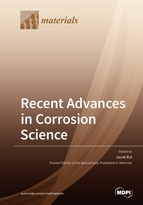Recent Advances in Corrosion Science
A special issue of Materials (ISSN 1996-1944). This special issue belongs to the section "Corrosion".
Deadline for manuscript submissions: closed (31 January 2020) | Viewed by 55159
Special Issue Editor
Interests: applied electrochemistry; corrosion science; surface engineering; surface chemistry; non-stationary processes
Special Issues, Collections and Topics in MDPI journals
Special Issue Information
Dear Colleagues,
The dynamic development of the global industry and growing demand for new material technologies generates constantly increasing problems regarding premature material degradation and the requirement to determine corrosion mechanisms and to develop new protection/evaluation approaches. Corrosion resistance depends on numerous determinants, depending on material structure and chemistry, but also on complex environmental factors. It is highly challenging to obtain consensus between high resistance and economic factors. On the other hand, inadequate levels of corrosion control create serious hazards to life and the environment.
The Special Issue “Recent Advances in Corrosion Science” is aimed at presenting a collection of original research and reviews focused on current engineering problems and discussing the available solutions on the topic of corrosion failure mechanisms, advances in corrosion protection and evaluation techniques ranging from industrial to nanoscale applications.
Dr. Jacek Ryl
Guest Editor
Manuscript Submission Information
Manuscripts should be submitted online at www.mdpi.com by registering and logging in to this website. Once you are registered, click here to go to the submission form. Manuscripts can be submitted until the deadline. All submissions that pass pre-check are peer-reviewed. Accepted papers will be published continuously in the journal (as soon as accepted) and will be listed together on the special issue website. Research articles, review articles as well as short communications are invited. For planned papers, a title and short abstract (about 100 words) can be sent to the Editorial Office for announcement on this website.
Submitted manuscripts should not have been published previously, nor be under consideration for publication elsewhere (except conference proceedings papers). All manuscripts are thoroughly refereed through a single-blind peer-review process. A guide for authors and other relevant information for submission of manuscripts is available on the Instructions for Authors page. Materials is an international peer-reviewed open access semimonthly journal published by MDPI.
Please visit the Instructions for Authors page before submitting a manuscript. The Article Processing Charge (APC) for publication in this open access journal is 2600 CHF (Swiss Francs). Submitted papers should be well formatted and use good English. Authors may use MDPI's English editing service prior to publication or during author revisions.
Keywords
- Electrochemistry of corroding interfaces
- Local corrosion processes at the micro- and nanoscale
- Electrochemical protection of metals
- Industrial-scale processes and corrosion monitoring
- Advances in corrosion measurement techniques
- Corrosion-resistant coatings and their characterization







